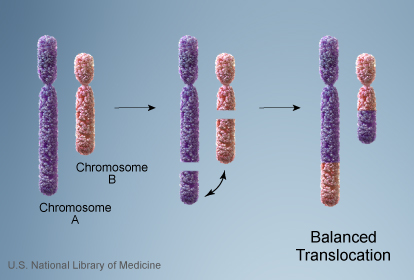|
|||||||||||||||
|

CLICK ON weeks 0 - 40 and follow along every 2 weeks of fetal development
|
||||||||||||||||||||||||||||
|
Chromosome errors may explain brain birth defects Balanced Chromosomal Abnormalities — or BCAs — are structural changes to the human genome. They may account for a large portion of birth defects affecting how our brain develops and functions. New findings were just presented at the American Society of Human Genetics (ASHG) 2015 Annual Meeting in Baltimore, MD. BCAs are changes to the structure of a chromosome where one or more fragments of DNA break apart and reattach elsewhere in the genome, either to the same chromosome or on a different one. In the simplest form, a single fragment moves to another region of the genome. But, BCA rearrangements can involve many fragments attaching to many chromosomes. Unlike Chromosomal Deletions or Duplications, BCAs do not generate gain or loss of genetic material — they disrupt the function of DNA. Fragment attachment points create DNA breaks, first from their original location and then in their new location. These breaks are implicated in birth defects found in our developing neurologic system.
Because no genetic material is gained or lost, conventional gene analysis tests cannot easily detect BCAs — and therefore don't assign much importance to them as significant cause for alarm. But Dr. Redin and her colleagues used a modified version of whole-genome sequencing to locate large, overlapping strands of DNA, and found breakpoints. "As a first step, we looked at how the breakpoint locations mapped relative to known disease genes, to see how many of the defects we observed in patients could be explained by these disruptions," Dr. Redin said.
The researchers also studied other genomic features near the breakpoints to see what may be triggering the DNA to break apart at any specific location. Unsurprisingly, they observed that breakpoints tend to coincide with known recombination 'hotspots' — specific regions where genetic exchange between a person's corresponding chromosomes occur.
Researchers are currently conducting a more detailed analysis of the 24 percent of breakpoints located between genes and how these may affect brain development. Presentation: Dr. Redin presented her research on Saturday, October 10, 2015, from 9:35-9:55 a.m., in Hall F of the Baltimore Convention Center. Press Availability: Dr. Redin will be available to discuss this research with interested media on Friday, October 9, 2015, from 11:00 a.m.-12:00 p.m., in the ASHG 2015 Press Office (Room 301). Reference: Redin C et al. (2015 Oct 10). Abstract: Characterizing de novo balanced cytogenetic abnormalities through sequencing in 147 subjects with multiple congenital abnormalities. Presented at American Society of Human Genetics 2015 Annual Meeting. Baltimore, Md. |
Oct 14, 2015 Fetal Timeline Maternal Timeline News News Archive
|
||||||||||||||||||||||||||||


